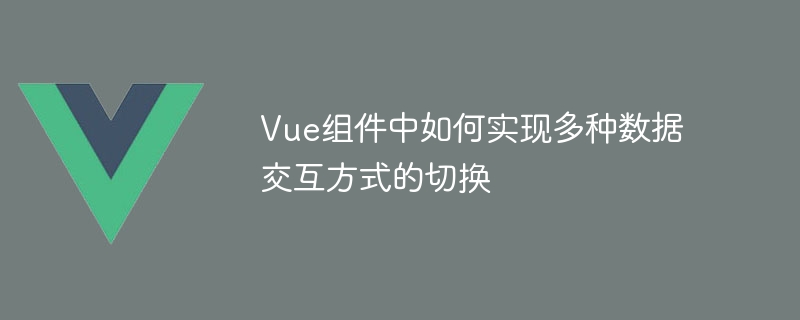Vue元件中如何實作多種資料互動方式的切換
- 王林原創
- 2023-10-08 11:37:47778瀏覽

Vue元件中如何實作多種資料互動方式的切換
在Vue元件開發中,常常會遇到需要切換不同的資料互動方式的場景,例如透過API請求資料、透過表單輸入資料或透過WebSocket即時推送資料等等。本文將介紹如何在Vue元件中實現這種多種資料互動方式的切換,並且會提供具體的程式碼範例。
方式一:API請求資料
在某些情況下,我們需要透過API請求資料來取得後台的資料。以下是使用axios函式庫發送API請求的範例:
<template>
<div>
<ul>
<li v-for="item in items" :key="item.id">{{ item.name }}</li>
</ul>
<button @click="fetchData">Fetch Data</button>
</div>
</template>
<script>
import axios from 'axios';
export default {
data() {
return {
items: [],
};
},
methods: {
fetchData() {
axios.get('/api/data')
.then((response) => {
this.items = response.data;
})
.catch((error) => {
console.log(error);
});
},
},
};
</script>上面的範例中,當點擊"Fetch Data"按鈕時,會傳送一個GET請求到後台的/api/data接口,並將返回的資料渲染到頁面中。
方式二:表單輸入資料
在使用者需要填寫表單的情況下,我們可以透過監聽表單輸入事件來取得使用者輸入的資料。下面是一個簡單的表單輸入範例:
<template>
<div>
<form @submit.prevent="handleSubmit">
<input type="text" v-model="username" placeholder="Username" />
<input type="password" v-model="password" placeholder="Password" />
<button type="submit">Login</button>
</form>
<p>{{ message }}</p>
</div>
</template>
<script>
export default {
data() {
return {
username: '',
password: '',
message: '',
};
},
methods: {
handleSubmit() {
// 处理表单提交逻辑
// 可以将用户输入的数据发送到后台,或者进行其他操作
this.message = `Welcome, ${this.username}!`;
this.username = '';
this.password = '';
},
},
};
</script>上面的範例中,當使用者輸入使用者名稱和密碼,並點擊"Login"按鈕時,會觸發表單的提交事件handleSubmit。在handleSubmit方法中,我們可以對表單的資料進行處理,例如將使用者名稱顯示在頁面上,並清空輸入框中的資料。
方式三:WebSocket即時推送數據
如果需要即時推送數據,我們可以使用WebSocket來建立與伺服器的長連接,並透過WebSocket接收伺服器推送的數據。以下是使用Vue-WebSocket庫來建立WebSocket連接的範例:
<template>
<div>
<ul>
<li v-for="message in messages" :key="message.id">{{ message.content }}</li>
</ul>
</div>
</template>
<script>
import VueWebSocket from 'vue-websocket';
export default {
mixins: [VueWebSocket('ws://localhost:8080/ws')],
data() {
return {
messages: [],
};
},
methods: {
onMessage(event) {
// 处理接收到的推送消息
this.messages.push(JSON.parse(event.data));
},
},
};
</script>上面的範例中,透過Vue-WebSocket庫建立了一個WebSocket連接,連接的URL為ws://localhost:8080/ws。在onMessage方法中處理接收到的推播訊息,並將其渲染到頁面中。
方式切換
在Vue元件中實作多種資料互動方式的切換,我們可以利用Vue的條件渲染功能,根據不同的狀態來顯示不同的資料互動方式。下面是一個簡單的切換範例:
<template>
<div>
<div v-show="mode === 'api'">
<!-- API请求方式 -->
<ul>
<li v-for="item in items" :key="item.id">{{ item.name }}</li>
</ul>
<button @click="fetchData">Fetch Data</button>
</div>
<div v-show="mode === 'form'">
<!-- 表单输入方式 -->
<form @submit.prevent="handleSubmit">
<input type="text" v-model="username" placeholder="Username" />
<input type="password" v-model="password" placeholder="Password" />
<button type="submit">Login</button>
</form>
<p>{{ message }}</p>
</div>
<div v-show="mode === 'websocket'">
<!-- WebSocket方式 -->
<ul>
<li v-for="message in messages" :key="message.id">{{ message.content }}</li>
</ul>
</div>
<div>
<!-- 切换按钮 -->
<button @click="switchMode('api')">API</button>
<button @click="switchMode('form')">Form</button>
<button @click="switchMode('websocket')">WebSocket</button>
</div>
</div>
</template>
<script>
import axios from 'axios';
import VueWebSocket from 'vue-websocket';
export default {
mixins: [VueWebSocket('ws://localhost:8080/ws')],
data() {
return {
mode: 'api',
items: [],
username: '',
password: '',
message: '',
messages: [],
};
},
methods: {
fetchData() {
axios.get('/api/data')
.then((response) => {
this.items = response.data;
})
.catch((error) => {
console.log(error);
});
},
handleSubmit() {
// 处理表单提交逻辑
// 可以将用户输入的数据发送到后台,或者进行其他操作
this.message = `Welcome, ${this.username}!`;
this.username = '';
this.password = '';
},
onMessage(event) {
// 处理接收到的推送消息
this.messages.push(JSON.parse(event.data));
},
switchMode(mode) {
// 切换数据交互方式
this.mode = mode;
},
},
};
</script>上面的範例中,我們透過v-show指令根據不同的mode值來決定顯示哪種資料交互方式的內容。透過點擊不同的按鈕來切換mode的值,從而達到切換資料互動方式的效果。
總結
以上就是在Vue元件中實作多種資料互動方式的切換的方法。透過合理使用Vue的條件渲染功能,結合對應的程式碼範例,我們可以在開發過程中靈活切換不同的資料互動方式,以適應不同的業務需求。同時,這種方式也有助於提高程式碼的可維護性和可擴充性。希望這篇文章對你有幫助,謝謝閱讀。
以上是Vue元件中如何實作多種資料互動方式的切換的詳細內容。更多資訊請關注PHP中文網其他相關文章!

